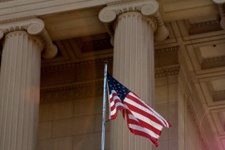Fitch places US on 'AAA' negative rating watch
16 Oct 2013
Global rating agency Fitch on Tuesday said it has placed the 'AAA' long-term foreign and local currency issuer default ratings (IDRs) of the United States on rating watch-negative (RWN).
 It has also placed all outstanding US sovereign debt securities and the US short-term foreign currency rating of 'F1+' on negative rate watch.
It has also placed all outstanding US sovereign debt securities and the US short-term foreign currency rating of 'F1+' on negative rate watch.
The outlook on the long-term ratings was previously negative. The US country ceiling has been affirmed at 'AAA' as of now.
The US authorities have not raised the federal debt ceiling in a timely manner before the Treasury exhausts extraordinary measures by 17 October. Failure to arrive at an agreement on debt limit would leave the Treasury with cash reserves of just $30 billion.
Fitch said although the Treasury would still have limited capacity to make payments after 17 October, it would be exposed to volatile revenue and expenditure flows. It may be unable to prioritise debt service, and it is unclear whether it even has the legal authority to do so.
''The US risks being forced to incur widespread delays of payments to suppliers and employees, as well as social security payments to citizens - all of which would damage the perception of US sovereign creditworthiness and the economy,'' Fitch noted.
Although Fitch believes that the debt ceiling will be raised soon, the political brinkmanship and reduced financing flexibility could increase the risk of a US default, it pointed out.
The delay in raising the debt ceiling also could undermine the role of the US dollar as the preeminent global reserve currency, by casting doubt over the full faith and credit of the US.
''This "faith" is a key reason why the US 'AAA' rating can tolerate a substantially higher level of public debt than other 'AAA' sovereigns,'' Fitch said.
The 'AAA' rating also reflects the halving of the federal budget deficit since 2010, which is now approaching a level consistent with debt stabilisation.
In addition, the passage of the American Taxpayer Relief Act on 1 January 2013, which implied a tax increase of more than $600 billion, has also contributed to the deficit reduction effort.
The US, however, continues to be a highly productive, diversified and wealthy economy with extraordinary monetary and exchange rate flexibility; and the exceptional financing flexibility afforded by the global reserve currency status of the US dollar and the depth and liquidity of domestic capital markets - in particular the US Treasury market.
The US sovereign credit profile also benefits from the respect for property rights, the rule of law and a high degree of social stability, Fitch said.
Fitch said it continued to expect that the US economy (and hence its tax base) remains more dynamic and resilient to shocks than its high-grade rating peers.
It also sees minimal fiscal and macroeconomic risks emanating from the financial sector and little risk to economic growth.
Fitch forecasts US economic growth to pick up from 1.6 per cent in 2013 to 2.6 per cent in 2014 and to average 3 per cent over 2015-17, before reverting to its assumed long-run trend growth rate of 2.25 per cent.
Fitch said the a resolution of the negative rate watch should come by the end of the first quarter of 2014, at the latest, but said the timing would depend on further developments and events, including the duration of any agreement to raise US government debt ceiling.
The projected recovery is supported by easing headwinds from private sector debt de-leveraging, a pick-up in the housing market and a gradual decline in unemployment, Fitch said.
Over the medium term, Fitch expects federal and general government (which includes states and local governments) gross debt stabilising next year and over the remainder of the decade to around 72 per cent and 104 per cent of GDP, respectively.
This is below the 80 per cent and 110 per cent thresholds that Fitch previously identified as being inconsistent with the US retaining its 'AAA' status.
''Nevertheless, public debt stabilisation at such elevated levels still render the US economy and public finances vulnerable to adverse shocks and in the absence of additional spending reform and revenue measures, deficits and debt will begin to rise again at the end of the decade,'' Fitch said, adding, ''The US is the most heavily indebted 'AAA' rated sovereign, with a gross debt ratio equivalent to double that of the 'AAA' median.






















